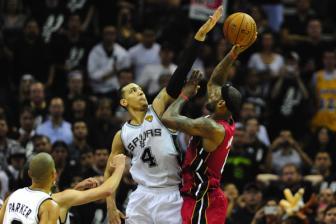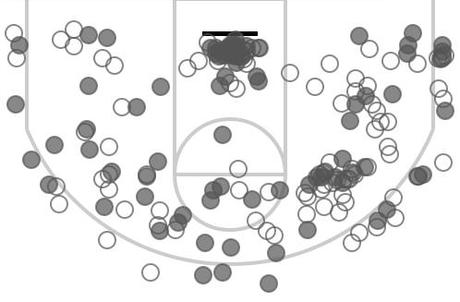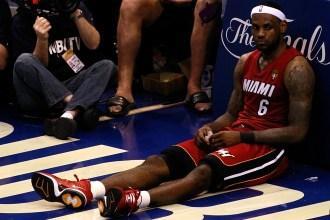Five seconds remained in the first half of the 2013 NBA Finals’ third act. With Miami Heat starting to assert themselves once again as the most dominant NBA team since Michael Jordan’s Bulls, once-forgotten Spurs’ sharpshooter Danny Green blocked a LeBron James layup, igniting a Spurs’ fastbreak. On the other end of the court, teammate Gary Neal, an

Watch out LeBron!: Danny Green gets a hand on LeBron James’ layup, a key play that jumpstarted the Spurs trouncing all over the Heat.
undrafted free agent out of La Salle University, drilled a 25-foot three-pointer as the buzzer sounded, and was quickly drowned out by the primitive cries of the San Antonio crowd. At halftime, the Spurs held a six-point lead over the Miami LeBrons (or “Heat”). Just 24 minutes of game time later, the Spurs delivered the third-largest blowout in NBA Finals’ history.
What does this drubbing say about the Miami Heat? Were the initial expectations too high? Are they too soft? Too small? Too reliant on one player? What the Spurs demonstrated last night is that the Miami Heat, a team that can never live up to the hype, is all of the above.
Not one, not two, not three…
On July 8th, 2010, LeBron James joined Dwyane Wade and Chris Bosh in Miami (er, South Beach). Shortly thereafter, there was a bold prediction that the Heat would be the first team in NBA history to reach 82-0.
“We didn’t come here to win one championship, not two, not three, not four, not five, not six, not seven…” -LeBron James
Well, a start to reaching 82-0 is winning your first game, a task the Heat failed to complete, losing to the Celtics, 88-80. Since then, basketball pundits have learned to accept the Heat as a team of mere mortals, but there has always been the underlying expectation that the Heat were built to fulfill the prophecy of winning a slew of championships. That expectation has led to the Heat’s (and especially LeBron’s) every move being scrutinized. When LeBron shoots jumpers, he needs to drive more. When he gets beat up in the paint, he needs to shoot jumpers. When he shoots a lot, he needs to get his teammates involved. When he passes the ball, he needs to command the basketball and shoot more. The unrealistic expectations set forward by the media, the fans, and the organization itself (cough, LeBron) play a major role in the Heat’s struggles to put out young, upstart teams as well as veteran powerhouses such as the San Antonio Spurs.
RELATED: The Decision’s One Year Anniversary
Watch as the aggression disappears
Chris Bosh is the poster boy of the Heat’s transition from an aggressive, “ground-and-pound”-based offensive team, to a jumpshot-happy, passive offensive model. Below is Chris Bosh’s shot chart for his first season in Miami:

Chris Bosh’s Shot Chart for the 2010-11 season. (Gray=Make, White=Miss)
As you can see, Bosh took the majority of his shots in the interior, which are easy, high-percentage layups, dunks, and short jumpers. Now, here is his shot chart from this postseason:

Bosh’s shot chart for the 2013 playoffs. (Gray=Make, White=Miss)
The chart above displays the evident change. Here, Bosh’s shots relocate to the perimeter, where he is missing much more than making it rain. In the Finals, the Spurs are deliberately allowing the Heat to take jumpshots by giving Miami’s shooters sizable cushions on defense. Whether it’s Bosh, LeBron, or anyone else, the San Antonio defenders are giving an evident cushion to lure the Heat into shooting jumpers. The Spurs’ defensive style is exposing what we have known for a while, that, as one of the smallest NBA teams, the Heat tend to account for their lack of size and get a bit shot-happy from behind the arc. When LeBron posts a goose-egg in the Free-Throws Attempted column (as he did in game 3), it’s a sign that he (and the rest of the Heat) are not being aggressive, settling for jumpshots instead of driving to the hoop.
The Miami LeBrons
LeBron even said it himself during this year’s Eastern Conference Finals: “I just went back to my Cleveland days.” In a rare mention of his “Cleveland days,” LeBron pointed out that the Heat have gone from a team dominated by the Big Three (LeBron, Wade, Bosh) to a team controlled by LeBron. And when their messiah fails, the Heat have no answer. Yes, a valid excuse for the

Get used to it: Miami’s supporting cast has completely abandoned LeBron, leaving their star lost and confused.
LeBron-reliance can be the knee injury that has been bothering Wade for the entirety of these playoffs, but there is no excuse for the fact that LeBron can post a triple-double (game 1) and still not bring home a winner. It’s just about time to face it, LeBron James is not Michael Jordan. James has a multitude of achilles’ heels. He simply cannot win the NBA Finals by himself, he needs help from the suddenly-absent supporting cast. A lasting image from game three is an exhausted LeBron James finally ploping onto the bench with five minutes to go, having done all he can to put the team on his shoulders, but receiving no help whatsoever. On the flip side, we see Tim Duncan, cool as ice, alongside Tony Parker and Manu Ginobili, barely having exerted himself in game three, watching (from the bench) Danny Green and Gary Neal pour in 51 combined points. The contrast is obvious, and the fact that Green and Neal can outscore the Heat’s entire “legendary” starting lineup (43 points) is shameful, and certainly, repairs are to be made in South Beach.
Prediction for the remainder of the NBA Finals
On one side, we see an exhausted superstar struggling to make basic plays to compensate for his nonexistent supporting cast; on the other we see the NBA’s true Big Three being outplayed by its own supporting cast. Oh, and those three old guys can are mighty fine basketball players as well. Spurs in 6.
By Sam Brief
Feel free to leave a comment below! Your opinion is always welcome.
Sam’s Sports Brief is on Twitter! Follow @SamsSportsBrief for even more insight and opinion.
<a href="http://polldaddy.com/poll/7176091">Take Our Poll</a>